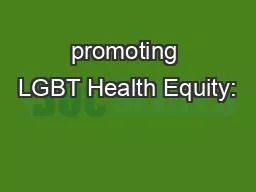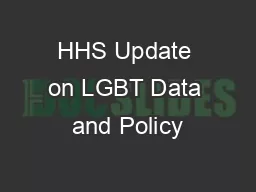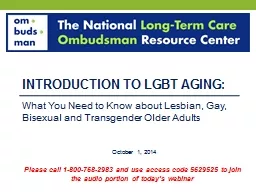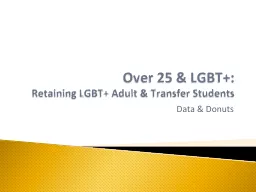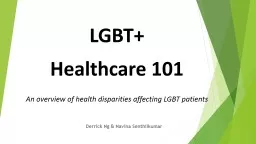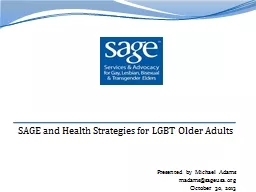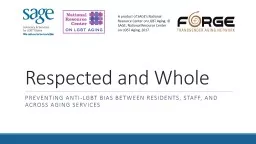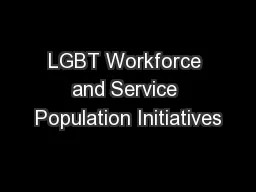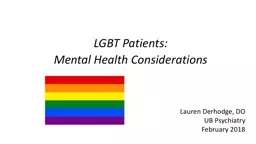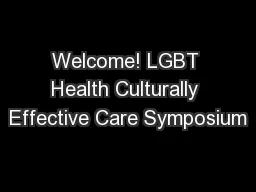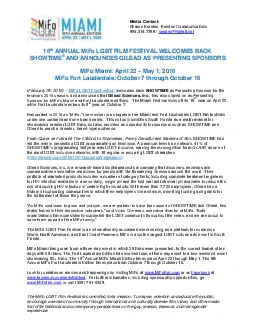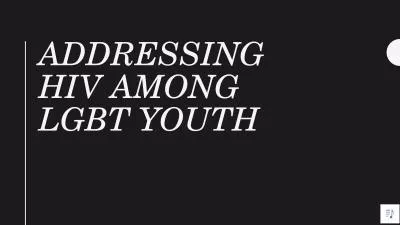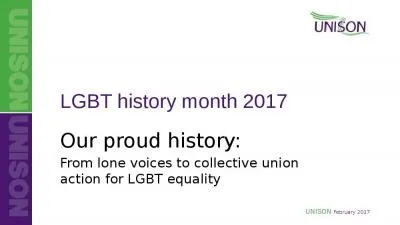PPT-promoting LGBT Health Equity:
Author : chiquity | Published Date : 2020-07-01
Challenges and Solutions 2018 Tim Vincent MS Deborah WyattONeal RN MSN CNS Shavar Johnson MSSA 2018 Note to the Reviewer Promoting LGBT Health Equity is a training
Presentation Embed Code
Download Presentation
Download Presentation The PPT/PDF document "promoting LGBT Health Equity:" is the property of its rightful owner. Permission is granted to download and print the materials on this website for personal, non-commercial use only, and to display it on your personal computer provided you do not modify the materials and that you retain all copyright notices contained in the materials. By downloading content from our website, you accept the terms of this agreement.
promoting LGBT Health Equity:: Transcript
Challenges and Solutions 2018 Tim Vincent MS Deborah WyattONeal RN MSN CNS Shavar Johnson MSSA 2018 Note to the Reviewer Promoting LGBT Health Equity is a training we custom developed for healthcare providers in Los Angeles seeking to better understand and engage LGBTidentifying patients experiencing health disparities The training is designed to increase knowledge of key cultural barriers experienced by LGBT individuals in the healthcare setting Cultural Humility Implicit Bias Sex Positivity and SOGI are key components of the course to guide participants towards identifying areas of organizational change Through this training participants were given the opportunity to develop inclusive strategies for LGBT staff and patients serving as a frame to develop posttraining structural interventions . Emma Coughlin and . Reily. Pond. Suicides and school. Gay and lesbian teens are two to three times more likely to commit teen suicide compared to other youths.. About 30% of all completed suicides have been related to sexual identity crisis.. AJ Pearlman. Office of Intergovernmental and External Affairs. Department of Health and Human Services. . “. Over the last three years, President Obama . and this Administration have put a top priority on improving access to healthcare for the LGBT community…And for the first time, we’re collecting data on the health of America’s LGBT population. This data will shine a spotlight on health disparities and show us exactly where we need to do better.”. What You Need to Know about Lesbian, Gay, Bisexual and Transgender Older Adults. October 1, 2014. Please call . 1-800-768-2983 . and use access code . 5629525 . to . join. t. he audio . portion of today’s webinar. Retaining LGBT+ Adult & Transfer Students. Data & Donuts. 31% . of LGBT+ identified college students leave college for a semester or longer. 1. 33%. of LGBQ and . 38% . of T* students seriously consider leaving their institution permenantly. Healthcare 101. An . overview of health disparities affecting LGBT . patients. Derrick Ng & Navina Senthilkumar. LGBT. . Demographics. LGBT Demographics. 3.6 million LGBT people . 600,000 trans people . James Flesher – LGBT Officer. Nomination proposed by: . Chris Slade. Seconded by: Michael Cotton. I aim:. To continue. . placing a real emphasis on welfare, and being available, open and supportive. Presented by Michael . Adams. madams@sageusa.org. October 30, 2013. SAGE - Services and Advocacy for GLBT Elders. Country’s oldest and largest LGBT aging organization. Services & info – . NYC HQ . Residents, . Staff, and across Aging Services. A product of SAGE’s National Resource Center on LGBT Aging. © SAGE, National Resource Center on LGBT Aging, 2017. . Sherrill Wayland . SAGE’s . Manager on National Projects. Human Resources and Administration. Office of Diversity and Inclusion . 0. Value Statement. In order to be a high performing organization in the 21. st. century that best serves our Veterans, VA must define diversity broadly to include all that makes us unique, including our sexual orientation and gender identity. Diversity and inclusion are more than legal or ethical imperatives; they are business imperatives to achieve high performance in public service.. Lauren Derhodge, DO . UB Psychiatry. February 2018. Objectives. Identify . populations at risk for health disparities. Discuss changes made throughout different versions of DSM concerning sexual orientation and gender identity. November 8, 2017. Emily Noonan. What are we going to do today?. Differentiate between . sexual orientation, biological sex, gender identity and gender expression. Review a short list of . key terms . 18thANNUAL MiFoWELCOMES BACK SHOWTIMEAND ANNOUNCESGILEAD AS PRESENTING SPONSORSMiFo Miami April 22 May 1 2016MiFo Fort Lauderdale October 7 through October 16February 25 2016--MiFo LGBT Film Festivalw Overview. Adolescents made up 20% of new HIV cases in 2017. LGBT youth are at an increased risk for HIV . Specifically men who have sex with men. Healthy People 2020 objectives include improving the gap in data collection and reduce HIV risk behaviors among LGBT youth. From lone voices to collective union action for LGBT equality. Early 1970s .... 1974. Howard Hyman. Letter to NALGO’s . Public Service . magazine suggesting a gay group. He asked “Am I the only one?”.
Download Document
Here is the link to download the presentation.
"promoting LGBT Health Equity:"The content belongs to its owner. You may download and print it for personal use, without modification, and keep all copyright notices. By downloading, you agree to these terms.
Related Documents

